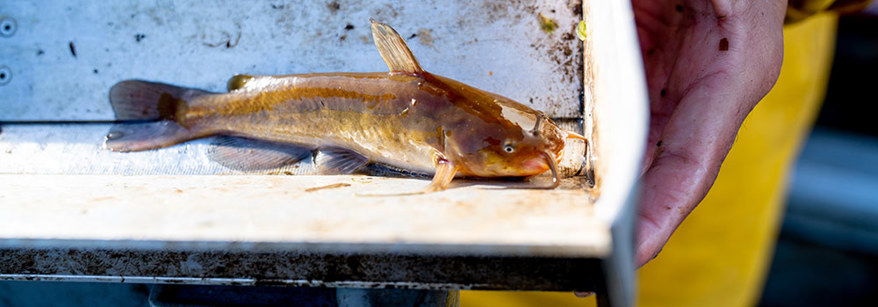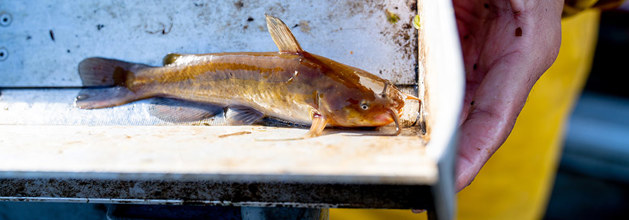Catfish are a pest fish which prey on taonga species such as koura and decrease water quality by stirring sediment. Catfish are prolific breeders and to date, population estimates indicate at least 186,000 fish in Lake Rotoiti. Catfish are indiscriminate eaters and prey on most species, contributing to the decline of native species in Lakes Rotoiti and Rotorua.
We’re working with Te Arawa Lakes Trust and research agencies to manage the population of Brown Bullhead Catfish which were found in Lake Rotoiti in March 2016 and then in Lake Rotorua in December 2018.
Community volunteers, appropriately name the Catfish Killas - coordinated by Te Arawa Lakes Trust and Bay of Plenty Regional Council, have been working alongside a professional netting contractor to remove catfish from the lakes and suppress catfish numbers. We have seen to date that netting can hold the population to a level, but netting alone is not able to decrease the population.
The solution: Research and community action
Community volunteers - the Catfish Killas - coordinated by Te Arawa Lakes Trust and Bay of Plenty Regional Council have removed over 100,000 catfish from Lakes Rotoiti and Rotorua since March 2016.
The 2019-2020 season was the busiest year on record, with over 62,000 catfish being removed with nets. We have seen to date that netting can hold the population to a level, but netting alone is not able to decrease the population.
In November 2019, Bay of Plenty Regional Council commissioned NIWA to undertake a feasibility study on potential biological control methods. Modelling indicated that a high level of suppression or eradication is possible by breeding and placing sterile (infertile) male catfish in Lake Rotoiti which will disrupt the breeding of catfish already in the lake, causing the population to decrease over the long term.
The biological control method is known as “triploidy” and involves breeding catfish in a hatchery or fish farm. The eggs of the catfish are then subjected to cold temperature or pressure, which causes the resulting hatchlings to be sterile once they are fully developed. The sterile catfish are then released into the lake and disrupt the success rates of reproduction by causing the next generation of eggs in the wild to be unfertilised.
This Biocontrol is not considered to involve genetic modification by the Environmental Protection Agency (EPA) and is regulated by multiple Central Government agencies in New Zealand.
Q: How does the sterilisation work?
A: The method is known as “triploidy” and involves breeding catfish in a hatchery or fish farm. The eggs of the catfish are then subjected to cold temperature or pressure, which causes the resulting hatchlings to be sterile once they are fully developed. The sterile catfish are then released into the lake and disrupt the success rates of reproduction by causing the next generation of eggs in the wild to be unfertilised.
Q: Is biocontrol a form of genetic modification?
A: No - this not considered genetic modification by the Environmental Protection Agency (EPA) as the method does not change or interfere with an organism's DNA.
Q: How is the method used in the aquaculture industry?
A: The method is widely used in the aquaculture industry globally and has been available for many decades overseas. Sterilising farmed fish including salmon and trout can have a number of benefits. Sterilisation can restrict environmental impacts in preventing farmed genes from being introduced into wild populations by escapees. Fish & Game have produced sterile trout in New Zealand.
Q: Are there any ecological risks associated with this biocontrol?
A: Any impact of introducing additional catfish into the lake can very quickly be offset by increasing contractor netting, and further supporting volunteer efforts to net more wild catfish. Tagging the sterilised catfish before release into the lake means that if one is subsequently captured it can be re-released to effectively continue to the depopulation process.
This method of biocontrol is also regulated by multiple agencies and will require permits and rules to comply with from the Department of Conservation and Ministry for Primary Industries.
Q: Has the sterilisation of fish ever been successful in eradicating or supressing a population anywhere else in the world?
A: Yes. This method has been applied to sea lampreys in the great lakes in the United States of America in the mid 1990’s for a period of several years and research indicates the method was successful in reducing the population.
Q: What else will Regional Council / Te Arawa Lakes Trust be doing to contain catfish numbers before the sterile catfish are ready to be released?
A: Catfish Killas and contractor netting will continue at current levels for the foreseeable future in Lake Rotoiti and Rotorua.
Additional messaging regarding taonga species
We know that catfish are having a devastating effect on kōura populations. We also know of the risk of catfish being transported to other lakes or to the Kaituna river catchment.
The method of biocontrol is an additional tool, to support existing methods. It has been applied overseas and could suppress (and possibly eventually eradicate) catfish populations in Lake Rotoiti and Lake Rotorua in the long term. Further work is needed to understand how the biocontrol method could be applied effectively within Lake Rotoiti and Rotorua.
While this method of biocontrol involves releasing additional catfish to the lake, the impacts will be off-set (as we head towards eradication we hope that wild catfish will become so rare that our catch is dominated by ‘sterile’ released fish) in Lake Rotoiti and Lake Rotorua. In the long term, however, our taonga species would recover as catfish numbers decrease.
Why not reduce the catfish population by offering a bounty?
Previous attempts to control pests based on bounties – most notably in NZ with possums in the 1950s - have been ineffective in reducing pest populations. By financially incentivising the capture / killing of pests it can promote a ‘harvesting’ culture where as soon as the pest starts getting hard to catch the hunters will move on to easier hunting grounds, allowing the population to recover. In certain circumstances it can even incentivise illegal releases in new environments to ensure a ready supply of the pest can be maintained.
Is there a risk that the catfish will change gender?
Only certain families of fish species have the ability to change gender and this doesn’t include catfish. There is a paper by Berkeley University which explains it more detail.
What are the sterile fish going to eat? Will they will just eat more koura?
Sterile catfish have the same diet as fertile catfish however through the use of contractor netting and the continued efforts of the Catfish Killas the total number of catfish released will be less than the total number caught in each year. The total number of catfish likely to be released in any given year is still to be determined and forms a part of the research being undertaken to ensure that undue pressure isn’t put on koura populations. Research has already been undertaken on the impact of catfish on koura and ongoing monitoring of the koura population will continue in the lake on an ongoing basis.
How will we stop the fertile catfish mating too?
The release of sterile male catfish cannot stop fertile catfish pairs from breeding. Each sterile male catfish can prevent the hatching of up to 6,000 catfish eggs in each breeding season when breeding with a fertile female.
The proposed method of producing sterile males achieves the same result as if they had a vasectomy. The sterilisation would not pass on or transfer to other catfish or taonga species.
Project updates

We are delighted to announce that Amohia Peka is the recipient of a grant from Bay of Plenty Regional Council to fund catfish biocontrol Masters degree.
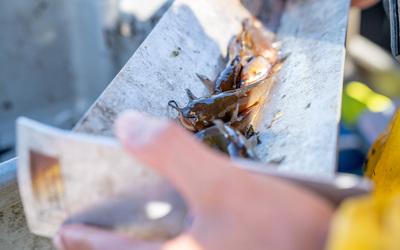
The goal of eradicating Brown Bullhead Catfish in Lakes Rotoiti and Rotorua is being given another boost with investigation into a new biological control method.
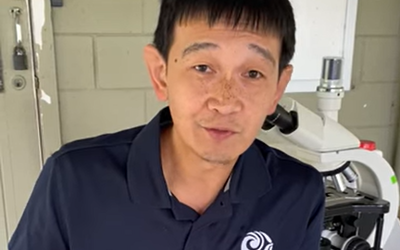
Recently scientist Alvin Setiawan and the team from NIWA New Zealand worked with Bay of Plenty Regional Council and the team from Te Arawa Lakes Trust to try and capture mature female catfish just before they spawned as part of a field trial to test the feasibility of catfish biocontrol.
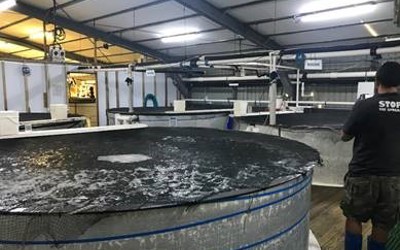
Bay of Plenty Regional Council, Te Arawa Lakes Trust and NIWA are looking for a Masters student preferably of Te Arawa descent to help assist with research on the catfish biocontrol project which is currently underway.
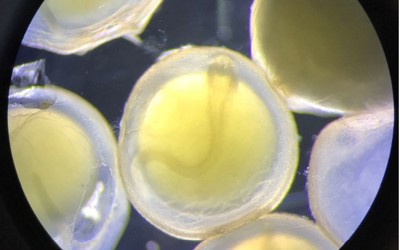
Following the delivery of 60 catfish to the NIWA research late last year, trials have indicated that further research is necessary to produce sterile male catfish.
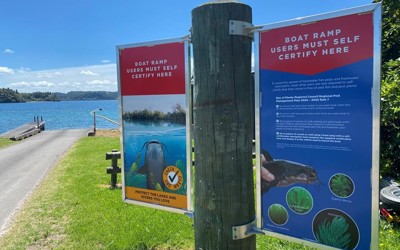
New rules to stop the spread of aquatic pests across the Bay of Plenty come in to force this summer with boat ramp users now required to self-certify that their vessels and trailers are free from freshwater fish and plant pests.
To try and better understand catfish behaviour, Bay of Plenty Regional Council undertook an acoustic tracking trial in Lake Rotoiti for a 13 month period from November 2018 to December 2019.
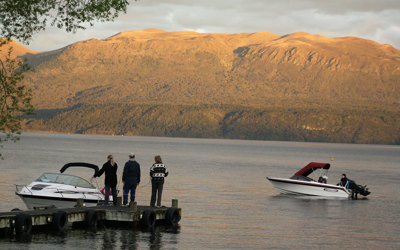
At dawn on Thursday October 1 an armada of watercraft is expected to descend on lakes Tarawera, Rotoiti and Okataina, marking the start of the trout fishing season.

